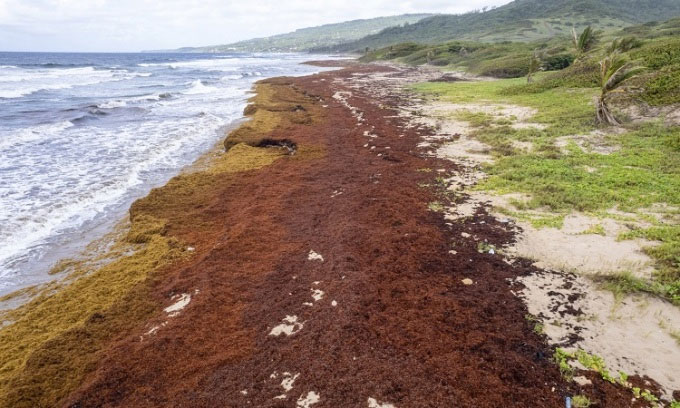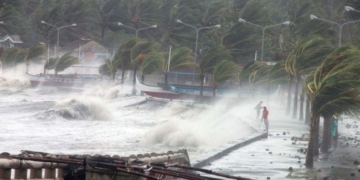Brown algae, known as sargassum, has spread across the Caribbean coastline from Puerto Rico to Barbados, killing fish and wildlife while releasing toxic gases.
More than 24 million tons of sargassum covered the Caribbean and Gulf of Mexico in June, breaking the previous record of 20 million tons set in 2018 (a 20% increase), according to the Optical Oceanography Laboratory at the University of South Florida, as reported by Phys.org on August 3. This unusually large amount of brown algae has washed ashore. The algae blanket surrounding an uninhabited island near France’s overseas territory of Saint Martin forced authorities to halt ferry services, kayaking, paddle boarding, and scuba diving tours. The turquoise waters around Pinel Island have turned into a thin brown sludge.

Sargassum on the beach in St. Andrew on July 27. (Photo: AP)
Scientists indicate that more research is needed to determine why the sargassum levels in the region have surged, but the United Nations Caribbean Environment Programme suggests possible causes including rising water temperatures due to climate change, fertilizers, and wastewater rich in nitrogen that nourish the algae. “This year is the worst in history,” shared Lisa Krimsky, a researcher with the Florida Sea Grant program focused on coastal protection. “Sargassum completely destroys the area. The excessive algae significantly impacts the environment. The decomposition of the algae alters water temperature and pH balance, leading to a decline in seagrass, coral, and sponge populations“.
The density of algae in many areas of the eastern Caribbean has reached such levels that Guadeloupe declared a health emergency at the end of July. Local authorities warned some communities about the hydrogen sulfide gas emitted from massive piles of rotting algae. This gas, which has a rotten egg smell, can affect individuals with respiratory conditions such as asthma.
Last month, the United States also declared a federal emergency after the Virgin Islands reported excessive sargassum clogging machinery at a desalination plant near St. Croix, causing difficulties in producing water and meeting demands during a drought. Additionally, the power plant in the islands relies on pure water from the desalination facility to reduce emissions. Disruptions in water supply will force the government to use a more expensive and limited diesel fuel.
Moderate levels of sargassum help filter water and absorb carbon dioxide, playing a crucial role in the habitats of fish, turtles, shrimp, crabs, and many other organisms. Sargassum is also used in fertilizers, food, biofuels, building materials, and pharmaceuticals. However, excessive accumulation offshore or on beaches can harm tourism and the environment. On Union Island in the Saint Vincent and the Grenadines, the invasion of sargassum has forced some resorts to close for five months in recent years.
Sargassum also damages the fishing industry in the Caribbean, destroying boat engines and fishing gear or preventing fishermen from accessing boats and fishing grounds. The abundance of sargassum is believed to be a contributing factor to the recent mass die-offs of thousands of fish in Martinique. Animal rights activists are also concerned about the plight of endangered sea turtles. Some turtles have become entangled in the algae or are unable to nest due to the algae blanket covering the sandy shores.
In the Cayman Islands, authorities previously conducted a trial program to dump over 268 square meters of algae into the water. However, on August 2, they announced the project’s halt as the decomposition of the algae rendered disposal efforts futile. Some island nations are using machinery to remove algae from the beaches, but scientists warn that this method can cause erosion and potentially destroy endangered turtle nests.


















































